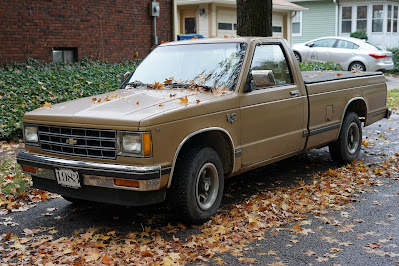Wednesday, October 30, 2024
1974 Mercury Montego MX Brougham
1991 Chrysler LeBaron GTC Convertible
Tuesday, October 29, 2024
1976 Cadillac Eldorado
Monday, October 28, 2024
1986 Dodge Omni
1951 Chevrolet 3100 1/2-Ton Truck
Sunday, October 27, 2024
1924 Ford Model T Doctor's Coupe
1980 Oldsmobile Cutlass Calais
For 1980, the "Calais" name badge signified the tip-top tier of the personal luxury coupe G-body Cutlasses, even higher up the luxo ladder than the Supreme and Supreme Brougham.
$7,199 was the base MSRP, about $27,500 in constant dollars, and it got you a two-door notchback coupe with a Buick-sourced 3.8L pushrod V-6 with a 2-barrel carburetor and 110 SAE net horsepower, backed by a three-speed automatic. Performance was typical Malaise-era, with zero-to-sixty times in the high thirteen second range.
Buyers could opt for a 105hp Olds 260 cubic inch V-8, or a 305 Chevy 4-barrel small-block putting out 155 ponies. (Or an Olds 350 diesel V-8, if they liked long chats with the mechanics at their dealership.)
This Yellow '80 Cutlass Calais with a Light Camel vinyl landau top was photographed in March of 2019 using a Canon EOS M mirrorless camera and an EF-M 18-55mm f/3.5-5.6 IS zoom lens.
Saturday, October 26, 2024
2020 Bentley Continental GTC V8
Friday, October 25, 2024
1965 Chevrolet Impala Convertible
2007 Saturn Sky Red Line
Thursday, October 24, 2024
1989 Mercedes-Benz 560SL
Wednesday, October 23, 2024
1995 Chevrolet Monte Carlo LS
Tuesday, October 22, 2024
2015 Alfa Romeo 4C
Monday, October 21, 2024
1980 Pontiac Catalina
Sunday, October 20, 2024
1932 Chevrolet Confederate Deluxe
Saturday, October 19, 2024
1965 Ford Mustang 2+2 GT
Friday, October 18, 2024
1965 Ford Galaxie 500 XL Convertible
Thursday, October 17, 2024
1992 Mercury Capri
1951 Dodge Meadowbrook
Wednesday, October 16, 2024
1991 Volkswagen Corrado
Tuesday, October 15, 2024
1977 Pontiac Firebird Trans Am
Monday, October 14, 2024
1981 Volvo 240 GLT Turbo Wagon
Sunday, October 13, 2024
1985 BMW 635CSi
1983 Chevrolet S-10
Saturday, October 12, 2024
1956 Chevrolet 210
Friday, October 11, 2024
1974 Chevrolet Monte Carlo
In 1973, OPEC announced an oil embargo directed at the nations that had supported Israel during the Yom Kippur War. The effects on the U.S. economy were harsh.
"The average US retail price of a gallon of regular gasoline rose 43% from 38.5¢ in May 1973 to 55.1¢ in June 1974. State governments asked citizens not to put up Christmas lights. Oregon banned Christmas and commercial lighting altogether. Politicians called for a national gasoline rationing program. Nixon asked gasoline retailers to voluntarily not sell gasoline on Saturday nights or Sundays; 90% of gas station owners complied, which produced long lines of motorists wanting to fill up their cars while they still could."The effects on Detroit would trigger the first big round of downsizing and boost sales of compacts, as people suddenly had a reason to avoid "gas guzzlers".
Sales of one model weren't much affected, though.
Despite the embargo and the subsequent gas crisis, Chevrolet sold over 300,000 1974 Monte Carlos, up from the previous record sales year of '73 that saw almost 250,000 cross the curb.
The base engine was a 145bhp 2-bbl Turbo-Fire small block 350, and you could get a Turbo-Fire small block 400 in either 150bhp 2-bbl or 180bhp 4-bbl flavors, or splurge for a 235bhp big block Turbo-Jet 4-bbl 454 V-8.
Thursday, October 10, 2024
1968 Plymouth Road Runner
The side marker lights and grille tell us this Mist Green Plymouth Road Runner with an Antique Green vinyl top is a 1968.
The fact that it's a hardtop means it was made in the latter part of the model year, since the Road Runner was originally only available as a pillared coupe with a bench seat.
The 440 badges on the hood, if they're not lying, mean that someone's upgraded things in the engine bay from the original Road Runner 383 V8, since the '68 was only available with a 383 4bbl or a 426 Hemi. (The standard Road Runner 383 was a 335bhp version, with a hotter cam and other tweaks exclusive to the model, unless you ordered A/C, in which case you got the same Super Commando 330bhp 383 4bbl as in Uncle Lester's Fury.)
2007 Honda Pilot EX
For 2003, Honda jumped into the largish SUV market with the eight-passenger, three-row Pilot, manufactured primarily at its plant in Alabama...

-
The fifth generation of Honda's sporty Prelude coupe launched for the 1997 model year. Wheelbase was up by two inches over the previous ...
-
1939 was a transitional model year for the Olds Motor Works (it was still a few years until the GM division would formally change its name t...




















































